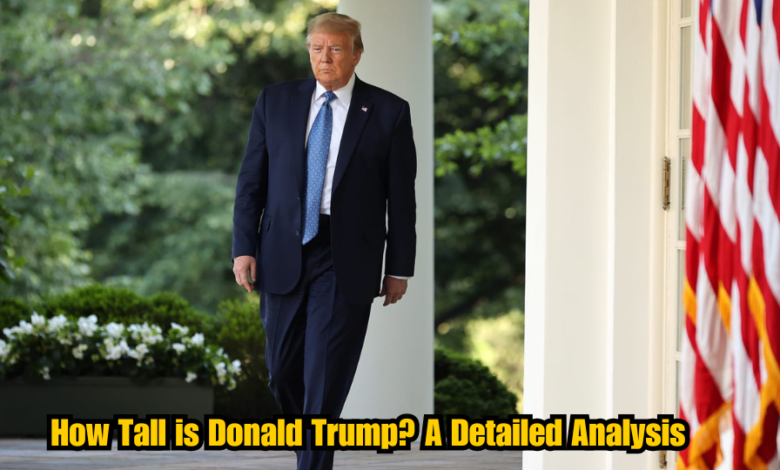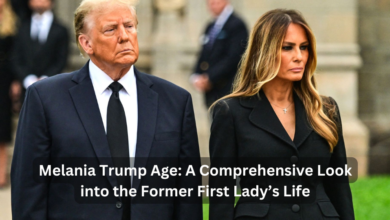How Tall is Donald Trump? A Detailed Analysis

Donald Trump, the 45th President of the United States, is one of the most talked-about political figures in recent history. Among the many public curiosities surrounding him, one frequent question is, how tall is Donald Trump? Height often becomes a focal point in discussions about celebrities and political figures, and Donald Trump is no exception. While Trump’s personality, policies, and business ventures dominate headlines, many are intrigued by his physical stature. In this article, we’ll explore not just how tall Trump is, but why height matters in politics, the influence of public perception, and how Trump’s height compares to other political leaders.
Donald Trump’s Actual Height
As of the most recent information available, Donald Trump stands at 6 feet 3 inches (1.91 meters). This figure comes from a physical exam conducted during his presidency, which was widely reported. Trump’s height has often been discussed in conjunction with his weight, overall health, and fitness for office.
It’s important to note that height in public figures can sometimes be subject to exaggeration or inaccuracy, as is often the case with celebrities and politicians. In Trump’s case, the 6’3″ height has been confirmed by multiple sources, making it a reliable measurement. In addition to medical reports, this figure is consistent with appearances where Trump has stood next to other known figures of varying heights.
Comparisons to Other Political Figures
To put Trump’s height into perspective, let’s compare it to other prominent U.S. presidents and global leaders:
- Barack Obama: Trump’s predecessor, Barack Obama, stands at 6 feet 1 inch (1.85 meters), which makes Trump slightly taller.
- Joe Biden: The current president of the United States, Joe Biden, is around 6 feet (1.83 meters), making Trump taller by about 3 inches.
- Vladimir Putin: Russia’s President Vladimir Putin is significantly shorter than Trump, standing at around 5 feet 7 inches (1.70 meters).
- Emmanuel Macron: The President of France, Emmanuel Macron, is also shorter than Trump, standing at 5 feet 8 inches (1.73 meters).
Why is Height Important in Politics?
While it may seem trivial to focus on a politician’s height, research has shown that height can influence public perception. Taller individuals are often seen as more authoritative, confident, and capable. In fact, several studies suggest that taller candidates are more likely to win elections. This may be due to deep-rooted psychological associations between height and leadership qualities, dating back to evolutionary factors where taller individuals were seen as protectors or leaders of tribes.
How Trump’s Height Affects Public Perception
Donald Trump’s towering height plays into his larger-than-life persona. At 6’3″, he is significantly taller than the average American male, whose height is approximately 5 feet 9 inches (1.75 meters). This height gives Trump a physical presence that can dominate a room or stage, which may have contributed to his media image and public appeal.
Moreover, Trump is known for being a highly image-conscious individual. During his time in office, he was often concerned with how he was portrayed in the media, whether it was about his policies, wealth, or even his physical appearance. Trump’s height has become a part of that image, contributing to the perception of him as a powerful and commanding figure.
Height vs. Weight: A Public Discussion
While height is often a focal point, Trump’s weight has also been a topic of public discussion. During his presidency, his medical reports listed him at 243 pounds (110 kg), which places him in the category of obesity according to the Body Mass Index (BMI). For a man of Trump’s height (6’3″), the ideal weight range would typically fall between 176 and 216 pounds (79 to 98 kg).
However, Trump has dismissed concerns about his weight in typical fashion, emphasizing his overall health and mental acuity. In fact, Trump has often boasted about his energy levels, attributing them to his genetics and lifestyle. Despite criticism, he remained confident in his abilities to fulfill the demanding role of President, regardless of public speculation about his weight.
Tallest U.S. Presidents in History
Historically, Trump is among the taller U.S. presidents. Here’s a look at some of the tallest men to have occupied the Oval Office:
- Abraham Lincoln: The tallest U.S. president in history, Abraham Lincoln, stood at an impressive 6 feet 4 inches (1.93 meters).
- Lyndon B. Johnson: Another notably tall president, Lyndon B. Johnson, was 6 feet 3.5 inches (1.92 meters).
- Thomas Jefferson: One of the Founding Fathers, Thomas Jefferson, stood at 6 feet 2 inches (1.88 meters), making him tall by the standards of his time.
- Bill Clinton: Standing at 6 feet 2 inches (1.88 meters), Bill Clinton is also among the taller modern-day presidents.
Shorter U.S. Presidents
Conversely, some U.S. presidents have been notably shorter than Trump. Here are a few examples:
- James Madison: The shortest U.S. president, James Madison, stood at 5 feet 4 inches (1.63 meters).
- John Adams: Another relatively short president, John Adams, was about 5 feet 7 inches (1.70 meters).
- Harry S. Truman: President Truman stood at 5 feet 9 inches (1.75 meters), which was the average height for a man during his time.
Donald Trump’s Height in the Media
The media has long been fascinated by the physical appearances of politicians, and Donald Trump is no exception. His height, alongside his distinctive hairstyle and tanned complexion, has become part of his overall public persona. Often, Trump has used his physical presence to assert dominance in debates, meetings, and public appearances. For example, during his 2016 campaign debates, he used his height to physically tower over his opponents, a tactic that may have contributed to his perceived authority on stage.
In the world of politics, image can be just as important as policy, and Trump’s height has undoubtedly played a role in shaping the public’s perception of him as a strong and authoritative figure.
The Role of Height in Trump’s Business Career
Before entering politics, Trump was known primarily as a businessman and real estate mogul. His physical stature played a role in that career as well. As the face of the Trump brand, his height contributed to the larger-than-life image that helped him succeed in business. Trump Tower, his flagship property, is itself a symbol of grandeur and excess—attributes that align with Trump’s personality and public image.
In the business world, height can contribute to perceptions of power and confidence, both of which are important traits for someone in Trump’s position. His height, combined with his assertive personality, has likely contributed to his ability to negotiate deals and present himself as a dominant figure in the boardroom.
The Evolution of Trump’s Public Image
As Donald Trump’s public career has evolved from real estate magnate to reality TV star and finally to President of the United States, his physical stature has remained a key component of his persona. His height, in particular, has contributed to the way people perceive him in both business and politics. Trump’s ability to use his physical presence to his advantage is a skill that few can master, but it is one that he has honed throughout his career.
From the moment he announced his candidacy for the presidency, Trump’s image was carefully crafted to emphasize his strength, resilience, and ability to lead. His height was an important part of that image, as it helped him stand out—both literally and figuratively—from the crowded field of presidential candidates.
The Impact of Height in Elections
Height can play a subtle yet significant role in electoral outcomes. As previously mentioned, taller candidates often enjoy a psychological advantage. Research shows that voters tend to associate height with leadership, authority, and competence, which may explain why taller candidates have historically won elections more often than their shorter counterparts.
In Trump’s case, his height may have contributed to his ability to project strength and confidence, particularly during the heated 2016 election campaign. While his policies and rhetoric certainly played the central role, it is worth considering how his physical stature influenced voter perception, particularly in visual mediums such as televised debates and rallies.
Psychological Impact of Height on Leadership
The psychological impact of height is not limited to politics; it is also prevalent in business and other leadership positions. Studies have shown that taller individuals are more likely to be promoted to leadership roles and to earn higher salaries. This phenomenon is known as the “height premium,” and it applies across various industries and professions.
For someone like Trump, who has spent his entire life in the public eye, height likely contributed to his ability to command attention and respect. Whether in a boardroom, a rally, or a presidential debate, Trump’s height allowed him to physically dominate the space and project an image of power and authority.
Conclusion: The Influence of Donald Trump’s Height
In conclusion, Donald Trump’s height is an integral part of his public persona. Standing at 6 feet 3 inches, he is taller than many of his political peers and predecessors, which has contributed to the perception of him as a strong and authoritative figure. Height plays a subtle but important role in how we perceive leaders, and Trump has used his physical stature to his advantage throughout his career in both business and politics.
While height alone does not determine leadership qualities, it undoubtedly influences public perception. In Trump’s case, his height is just one of many factors that have contributed to his success in the political arena. By understanding the impact of height on leadership and public image, we gain a deeper insight into why Donald Trump remains such a dominant figure in both U.S. politics and the global stage.




